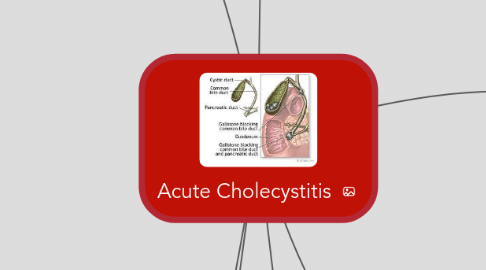
1. Clinical Picture
1.1. Symptoms
1.1.1. Fever
1.1.2. Pain
1.1.2.1. Site
1.1.2.1.1. RIGHT HYPOCHONDRIUM
1.1.2.2. Type
1.1.2.2.1. COLICKY
1.1.2.3. Onset
1.1.2.3.1. SUDDEN
1.1.2.4. Duration
1.1.2.4.1. MORE THAN 12 hrs
1.1.2.5. Radiation
1.1.2.5.1. BACK
1.1.2.5.2. SHOULDER
1.1.2.5.3. RIGHT HYPOCHONDRIUM
1.1.2.5.4. LEFT HYPOCHONDRIUM
1.1.2.6. Precipitating factor
1.1.2.6.1. Fatty Food
1.1.2.6.2. Movement
1.1.2.6.3. Breathing
1.1.2.7. Relieving Factor
1.1.2.7.1. Analgesics
1.1.3. Nausea & Vomiting
1.1.4. Distention & Constipation
1.1.5. Jaundice
1.2. Sign
1.2.1. General
1.2.1.1. TACHYCARDIA
1.2.1.2. PYREXIA
1.2.2. Local
1.2.2.1. TENDERNESS - RT HYPOCHONDRIUM
1.2.2.2. RIGIDITY - RT HYPOCHONDRIUM
1.2.2.3. MURPHY’S SIGN
1.2.2.4. BOAS SIGN
1.2.2.5. MASS
2. 4
2.1. GALL BLADDER RADIONUCLIDE SCAN
2.2. BLOOD COMPLETE PICTURE
2.2.1. Leukocytosis
2.3. URINE
2.3.1. BILIRUBIN
2.4. PLAIN X-RAY ABDOMEN
2.4.1. Radioopaque gall stones
2.5. ULTRASONOGRAPHY
2.5.1. Dilatation of billiary tree
2.5.2. Stones
2.5.3. Fluid
2.6. ORAL CHOLECYSTOGRAM
2.6.1. Not Used Nowdays
2.7. PERCUTANEOUS TRANSHEPATIC CHOLANGIOGRAPHY (PTC)
2.8. ENDOSCOPIC RETROGRADE CHOLANGIOPANCREATOGRAPHY (ERCP)
2.9. MAGNETIC RESONANCE CHOLANGIOPANCREATOGRAPHY (MRCP)
3. Differential Diagnosis
3.1. Common
3.1.1. ACUTE PANCREATITIS
3.1.2. PERFORATED DUODENAL ULCER
3.1.3. PERFORATED PEPTIC ULCER
3.1.4. APPENDICITIS
3.2. Rare
3.2.1. ACUTE PYELONEPHRITIS
3.2.2. HEPATITIS
3.2.3. MYOCARDIAL INFARCTION
3.2.4. PNEUMONITIS
4. 1
4.1. Calculus
4.1.1. Obstruct Cystic Duct
4.2. Acalculus
4.2.1. Cholesterosis
4.2.2. Cholesterol Polyposis
4.2.3. Cholecystitis glandularis proliferans
4.2.4. Diverticulosis of the gall bladder
4.2.5. Typhoid of Gall Bladder
5. 2
5.1. Inflamation
5.2. Localization
5.2.1. Ilues
5.2.2. Movement of Omentum
5.2.3. Loops of Intestine
5.3. Resolution
5.4. Mucocele
5.5. Empyema
5.6. Perforation
5.6.1. Generalized peritonitis
5.7. Local Abcess
5.8. Fistula
6. Complication
6.1. MUCOCELE
6.2. EMPYEMA
6.3. PERFORATION
6.3.1. ABSCESS
6.3.2. PERITONITIS
6.4. FISTULA
6.5. GALL STONE ILEUS
6.6. ACUTE PANCREATITIS
6.7. OBSTRUCTIVE JAUNDICE
7. Management
7.1. Conservative treatment
7.1.1. Nasogastric asp., IV fluids, Antibiotics
7.1.2. Antiemetics.
7.2. Surgical Treatment
7.2.1. Early ( within 48 hours).
7.2.2. Open/ Lap. Cholecystictomy
7.2.3. Cholecystostomy
7.2.4. Late ( start conservative then surgery)
